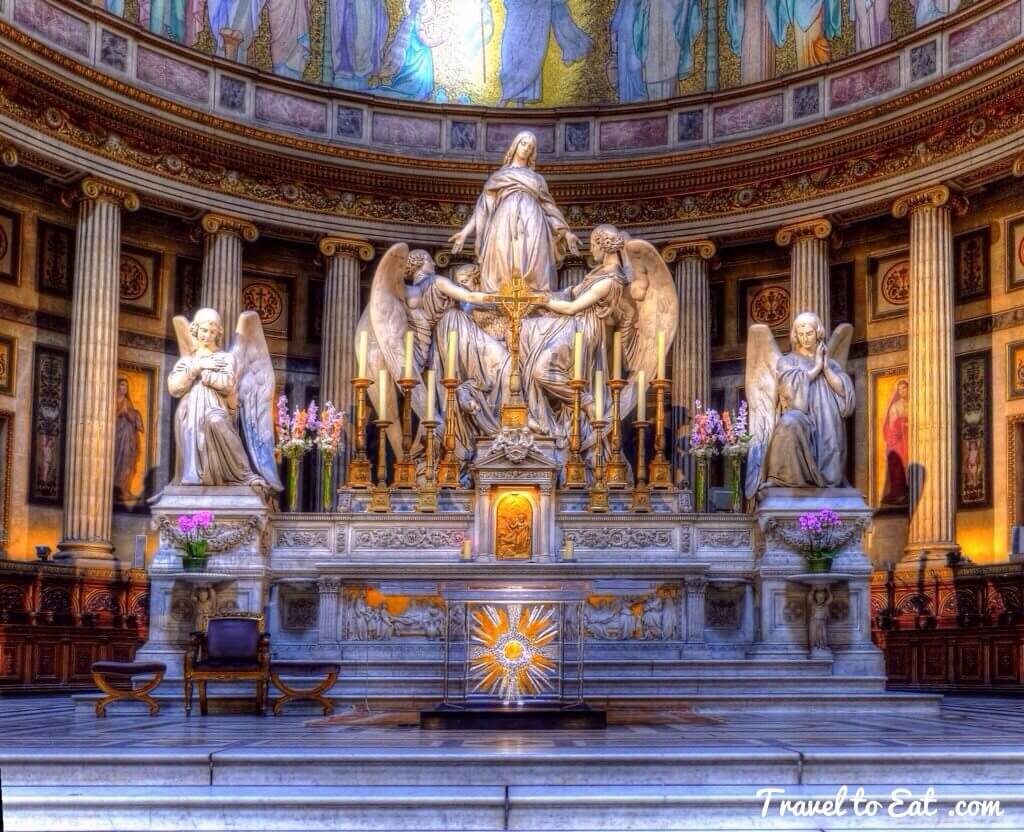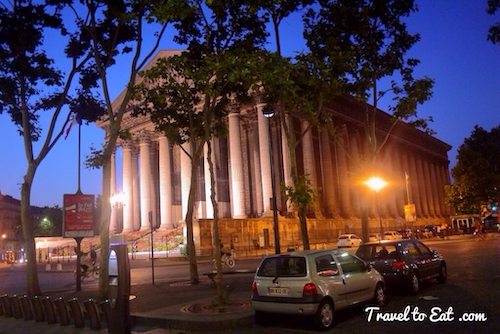
We first came across La Madeleine after the Beach Boys concert, it appeared like a Roman mirage in central Paris. Madeleine Church (more formally, L'église Sainte-Marie-Madeleine; less formally, just La Madeleine) is in the 8th arrondissement, centered at the end of rue Royale. This is on a line-of-sight between Gabriel's twin hôtels in the Place de la Concorde to the square established in 1755, as Place Louis XV. The Eglise de la Madeleine is situated between Place de la Concorde and the Palais Garnier opera house, in Haussmannian Paris. Its construction started in 1764 and was finished in 1842. Its appearance is not typical of a religious building, in the form of a Greek temple without any crosses or bell-towers. Its 52 Corinthian columns, each 20 meters (66 feet) high, are carried around the entire building. Napoleon wanted it to be a pantheon in honor of his armies. Inside, there are sculpture, paintings and the famous neo-Byzantine mosaic created by Charles-Joseph Lameire. The magnificent church organ was designed by Aristide Cavaillé-Coll. Throughout the year, both day and night, the church holds quality classical music concerts.
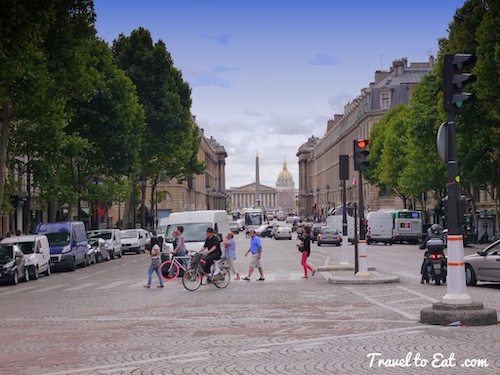

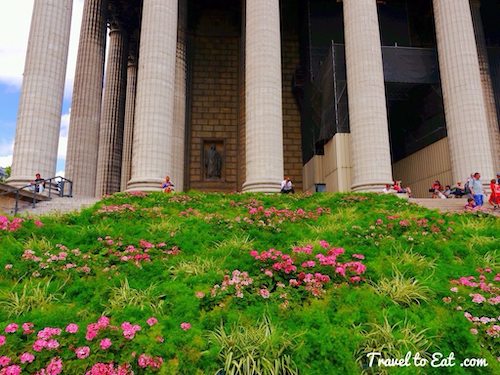

In the 12th century a synagogue was located on this site. Philip II of France and Bishop Maurice de Sully confiscated this synagogue and then consecrated it to Mary Magdalene in 1182. In 1757, a new design for a church was commissioned to be built on the site and construction began shortly afterward but was abandoned in 1764. In 1777, parts of this construction were razed and the project was restarted but quickly came to a halt with the start of the French Revolution. Finally, with the coming of Napoleon and his grandiose plans, the lovely Église Sainte-Marie-Madeleine was built. In 1806 Napoleon made his decision to erect a memorial, a Temple de la Gloire de la Grande Armée (“Temple to the Glory of the Great Army”); following an elaborate competition with numerous entries and a jury that decided on a design by the architect Claude Étienne de Beaumont (1757–1811), Napoléon made a characteristic personal decision, instead commissioning Pierre-Alexandre Vignon (1763–1828) to build his design on an antique Roman temple (the Maison Carrée, in Nîmes) The then-existing foundations were razed, preserving the standing columns, and work begun again.
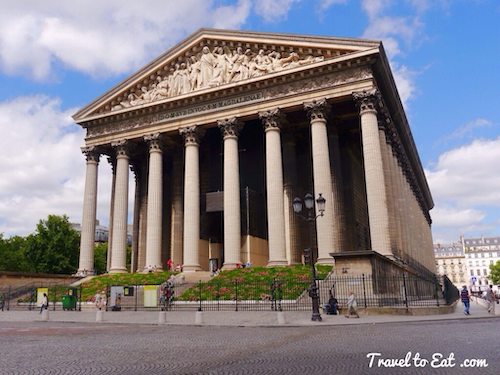
After the fall of Napoleon, with the Catholic reaction during the Restoration, King Louis XVIII determined that the structure would be used as a church, dedicated to Mary Magdalene. Vignon died in 1828 before completing the project and was replaced by Jacques-Marie Huvé. A new competition was set up in 1828-29, to determine the design for sculptures for the pediment, a Last Judgment, in which Mary Magdalene knelt to intercede for the Damned; the winner was Philippe Joseph Henri Lemaire. The July Monarchy rededicated the monument of repentance for Revolution as a monument of national reconciliation, and the nave was vaulted in 1831. In 1837 it was briefly suggested that the building might best be utilized as a train station, but the building was finally consecrated as a church in 1842.

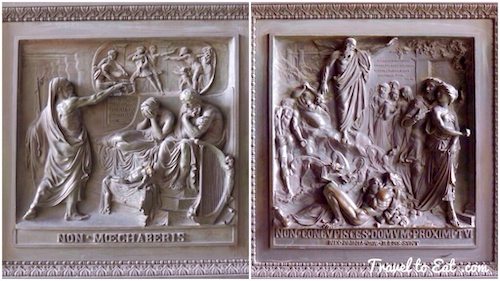
Before entering, you can admire the monumental bronze doors which bear reliefs representing the Ten Commandments. Because of the imposing structure, convenient central location and beautiful interior, the church is popular with fashionable Parisians for weddings and funerals. One of the most memorable funerals was Chopin’s in 1849 when Mozart’s Requiem was sung. Special permission had to be granted to include the female singers who remained hidden behind black velvet curtains. In fact, the funeral was delayed approximately two weeks while permission was obtained to allow women to participate in a manner that was deemed acceptable by the clergy.

The wax model depicting the baptism of Christ is situated in La Madeleine's “Chapelle des Fonts Baptismaux” by François Rude. The work was commissioned by the French Ministry of the Interior in 1838 and the marble version was installed in 1841. A plaster model is held in the Église de Ville-d'Avray and a further model is held by the Musée d'Angers. The Musée de Dijon holds a model used as a study for Christ's head and another model in wax is held by the Musée du Louvre.

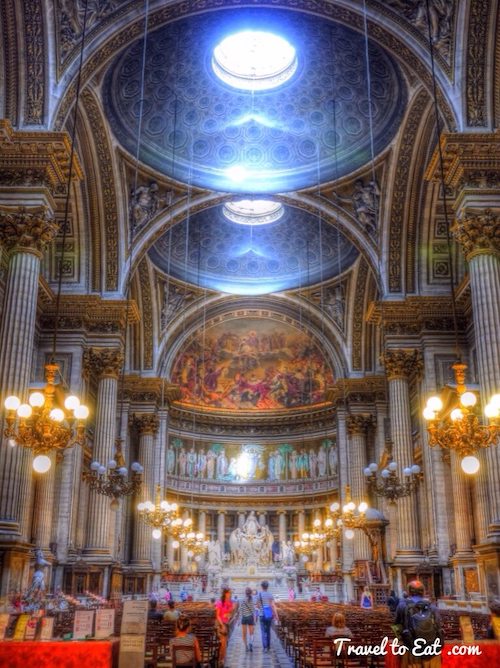
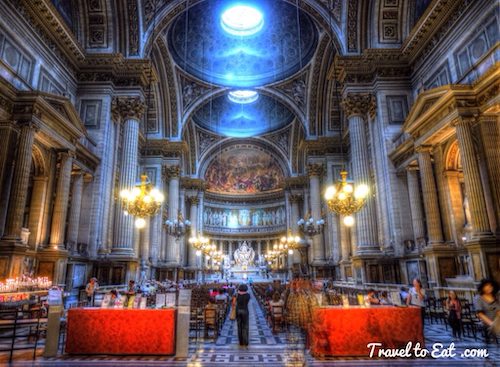
Inside, the church has a single nave with three domes over wide arched bays, lavishly gilded in a decor inspired as much by Roman baths as by Renaissance artists. Walking down the long nave, one passes under three large domes, supported by pendentives (triangular sections of vaulting between the rim of a dome and the arches that support it), decorated with colossal relief figures. Each dome is coffered and has a glazed oculus allowing in light, features that obviously recall the Pantheon. There are no other windows in the structure, making the interior a little dark.
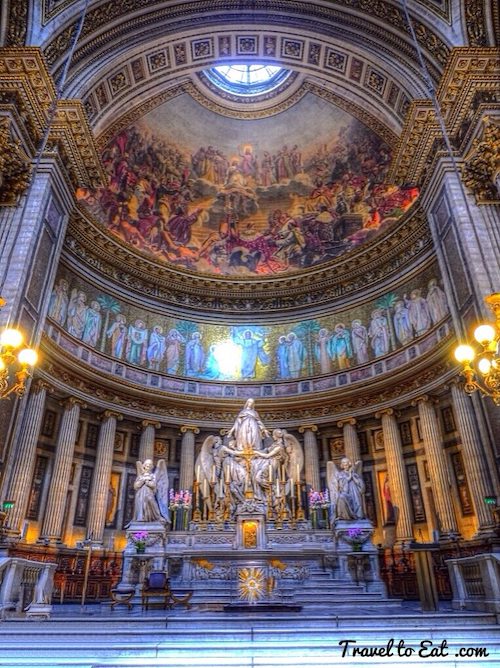
The half-dome above the altar is frescoed by Jules-Claude Ziegler, titled The History of Christianity, showing the key figures in the Christian religion with, a sign of its Second Empire date, Napoleon occupying center stage. Ziegler was born in 1804 in Langres, Haute-Marne. He was appointed knight of the Légion d'Honneur in 1825. He was the pupil of Dominique Ingres and began to participate in exhibitions at the Salon in 1832. Just below the dome is a Neo-Byzantine mosaic produced between 1888 and 1893, at the initiative of Father Le Rebours, parish priest at the time. The subject was composed by Charles-Joseph Lameire and Sevres made the colored glass tiles, under the direction of Augustus Martin Guilbert. The color effect is singular but respects the alternation of warm and cool tones of the whole building.
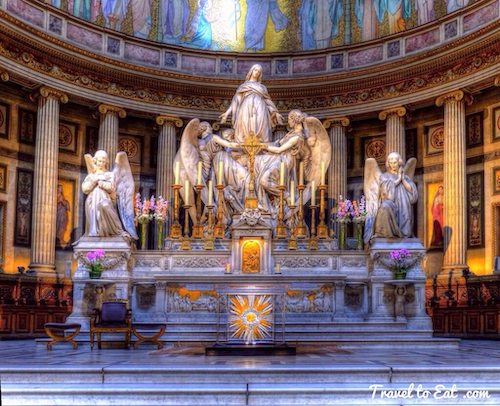
Behind the altar is a large statue depicting the ascension of Mary Magdalene. It was built in 1837 by Charles Marochetti. Marochetti was born in Turin. Political changes sent the family to France, where the boy, now a naturalized French citizen, was educated at the Lycée Napoléon. He went on to study sculpture at the École des Beaux-Arts, and spent long periods in Rome. Marochetti succeeded in projecting Romanticism in public monuments: in his marble relief of the Battle of Jemmapes (1833-34) on the Arc de Triomphe and, in a more original form, in the group of the Assumption of the Magdalene. He followed the French king Louis-Philippe into exile in the United Kingdom after the fall of the July monarchy in 1848. He spent the greater part of his time from then until his death in London. He lived in Onslow Square, and had a large studio, and his own foundry, nearby in Sydney Mews. His equestrian statue of Richard the Lionheart was displayed in the Great Exhibition, and a bronze copy was made in 1860 to be displayed in front of the Palace of Westminster, where it has remained ever since.



Above the drum oak entrance stands the great organ of Cavaillé-Coll (1846) which makes Madeleine one of the great music venues in Paris. In 1838, the parish put together a commission of specialists including Erard and composer Ambroise Thomas. The contract was awarded to the most famous organ builder of the time, Aristide Cavaillé-Coll. This magnificent instrument was as prestigious as Camille Saint-Saëns (1858) and Faure (1896). In harmony with the architecture, there are four Corinthian orders superimposed with columns and fluted pilasters that distribute door, forum and two sets of visible pipes. Two angels surround a sitting head of Christ in a medallion at the first level; third, pilasters were replaced by bearded Atlanteans who maintain books and fully carved columns. Two angels sitting on the symbols of the Passion, create the last order, dominated by a statue of Christ seated, blessing, while two angels play trumpet. We do not know the author of this remarkable woodwork although all the ornaments are gold. The celebrated pipe organ, built by Aristide Cavaillé-Coll in 1845, was restored by Cavaille-Coll's successor Charles Mutin in 1927, who also extended the manuals to 56 notes. Tonal modifications were carried out by Roethinger, Danion-Gonzalez, and Dargassies in 1957, 1971, and 1988, respectively. The position of titular organist has been held by many major organists and composers over the years including such composers as Camille Saint-Saëns and Gabriel Fauré.
This is a great church to visit, right across from the mustard shop Maille, lots of cafés and flower shops all around it. It is near the place de Concorde and definitely worth a look if you are in Paris. I have included a link to the schedule of concerts at La Madeleine which look very interesting and would be a fun night out in Paris.
[mappress mapid=”16″]
References:
Church Website: http://www.eglise-lamadeleine.com
Outside Statues: http://www.colourbox.com/image/saint-teresa-madeleine-church-in-paris-image-8770830?utm_expid=22365066-34.fcazlHfCSC-Yd0O3uzsCHQ.0&utm_referrer=https%3A%2F%2Fwww.google.com%2F
Bonjour Paris: http://www.bonjourparis.com/story/madeleine-church/
Smart History: http://smarthistory.khanacademy.org/vignons-the-church-of-la-madeleine.html
Pipe Organ: http://www.csa.com/discoveryguides/organs/review.pdf
Concerts: http://www.classictic.com/en/special/la_madeleine_paris/3180/

